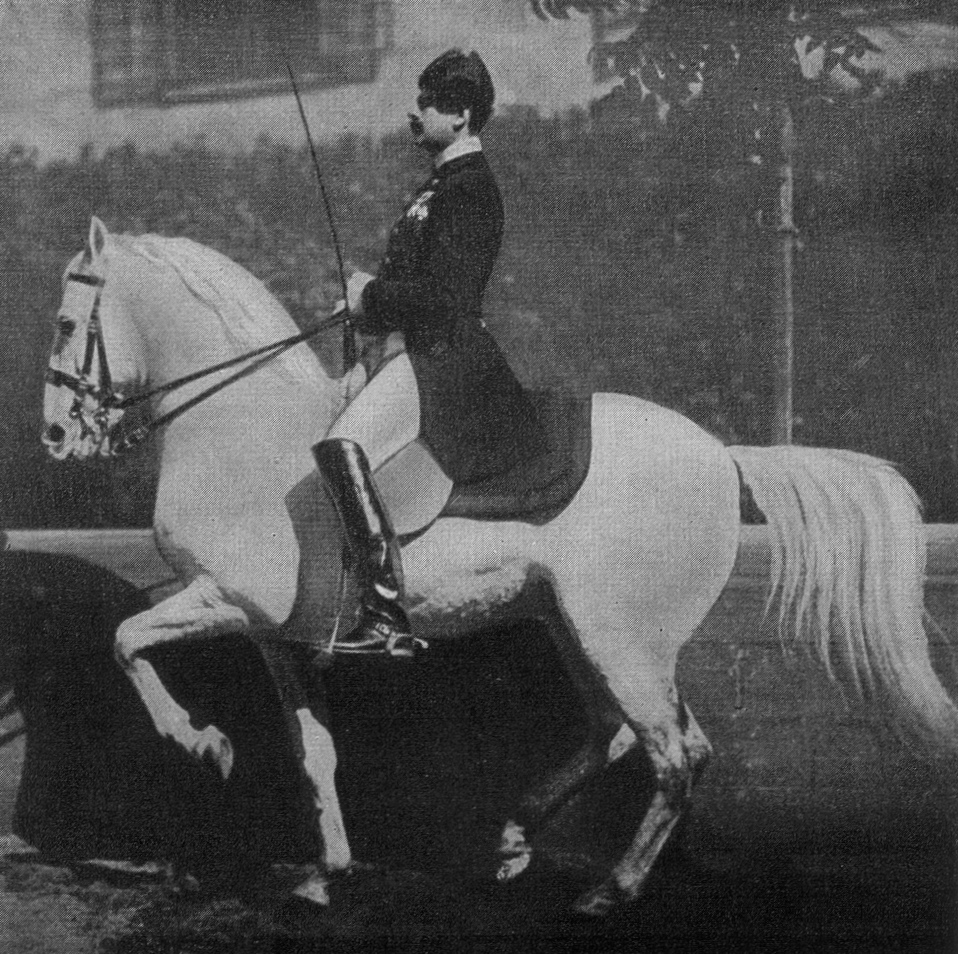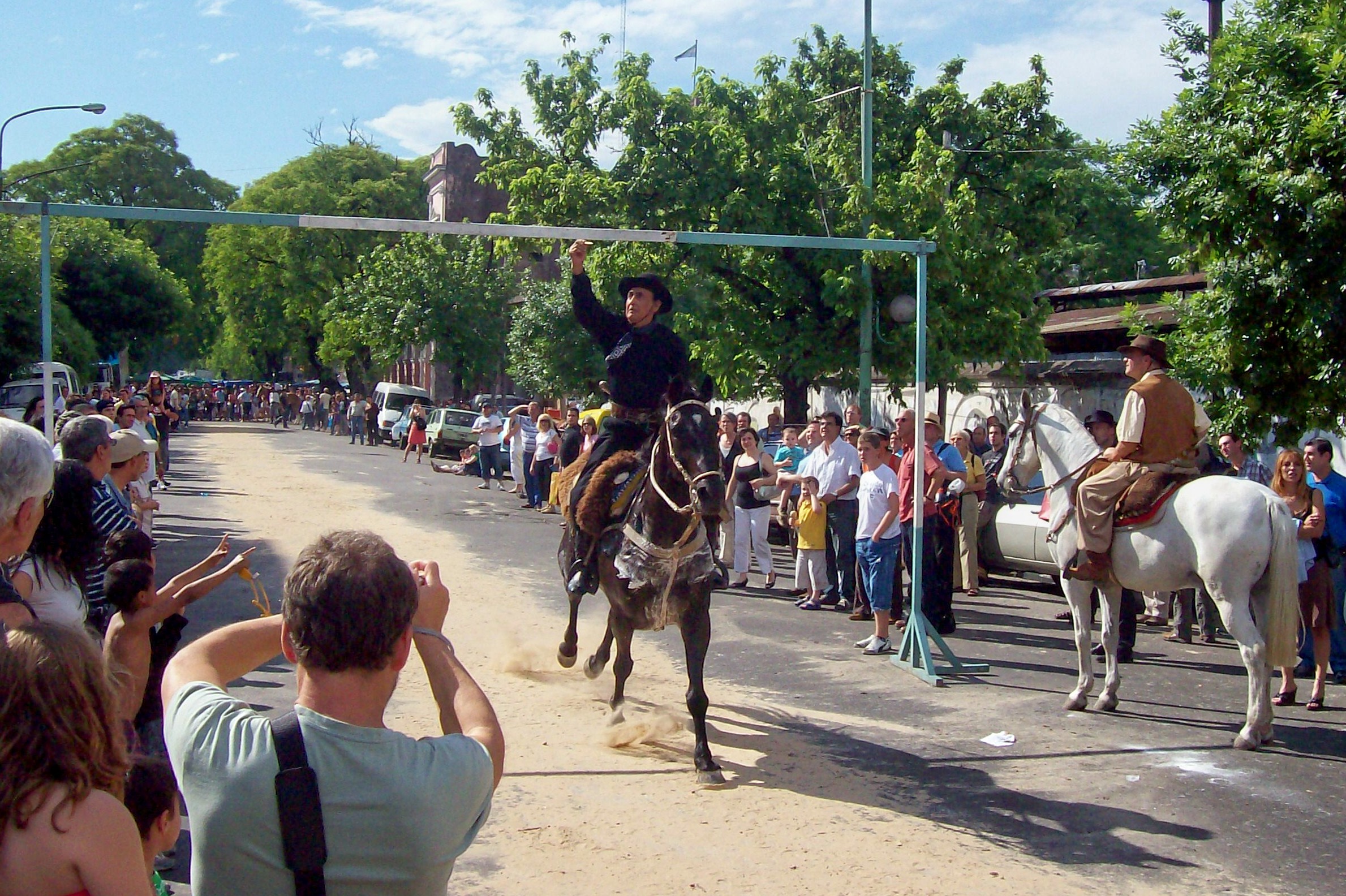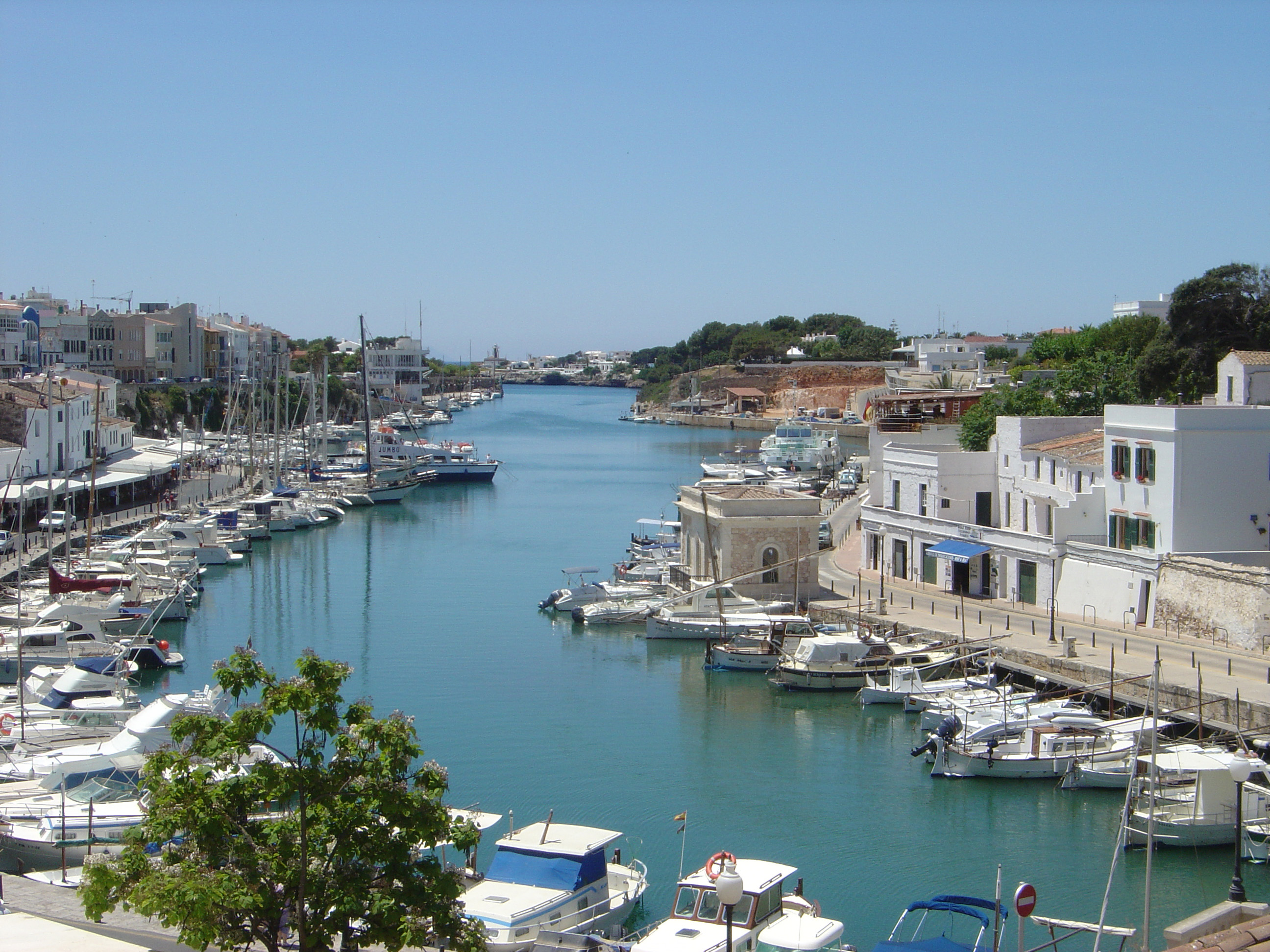|
Doma Menorquina
Doma menorquina is the traditional style of riding of the island of Menorca. It is closely associated with the Menorquín horse. Doma menorquina is based on classical dressage and resembles a combination of Haute Ecole (dressage) ("High School") and Doma vaquera disciplines. Usually, stallions 3–4 years old are trained. From the three basic gaits, walk, trot and gallop, training progresses to the Spanish walk, half pass, flying changes and piaffe and culminates in the ''bot'', or walking courbette. The remarkable ability of Menorcan horses in the ''bot'' is the most notable element of Menorcan riding; the rider sits effortlessly on the rigid back of the , the Menorcan saddle. Horses and riders are at the centre of local celebrations, in a tradition that may go back to the 14th century and incorporate elements of Christian, pagan and Moorish ritual. Some 150 riders participate in the festival of ''Mare de Déu de Gràcia'', the Birth of Mary, in Mahón (September 8–9) an ... [...More Info...] [...Related Items...] OR: [Wikipedia] [Google] [Baidu] |
Menorca Jaleo
Menorca or Minorca (from la, Insula Minor, , smaller island, later ''Minorica'') is one of the Balearic Islands located in the Mediterranean Sea belonging to Spain. Its name derives from its size, contrasting it with nearby Majorca. Its capital is Mahón ( ca, Maó), situated on the island's eastern end, although Menorca is not a province and forms a political union with the other islands in the archipelago. Ciutadella de Menorca, Ciutadella and Mahon are the main ports and largest towns. The port of Mahon is the second biggest natural port in the world. Menorca has a population of approximately 93,397 (at 1 January 2019). It is located 39°47' to 40°00'N, 3°52' to 4°24'E. Its highest point, called El Toro (Minorca), El Toro (from Catalan "''turó''" meaning ''hill''), is Above mean sea level, above sea level. History The island is known for its collection of European megalithic culture, megalithic stone monuments: naveta, ''navetes'', taula, ''taules'' and ''talaiots'' ... [...More Info...] [...Related Items...] OR: [Wikipedia] [Google] [Baidu] |
Piaffe
The piaffe () is a dressage movement where the horse is in a highly collected and cadenced trot, in place or nearly in place. The center of gravity of the horse should be more towards the hind end, with the hindquarters slightly lowered and great bending of the joints in the hind legs. The front end of the horse is highly mobile, free, and light, with great flexion in the joints of the front legs, and the horse remains light in the hand. The horse should retain a clear and even rhythm, show great impulsion, and ideally should have a moment of suspension between the foot falls. As in all dressage, the horse should perform in a calm manner and remain on the bit with a round back.Carlos Henriques Pereira, « Le piaffer », dans Dressage et Ethologie, Editions Amphora, 2011, 285 pp. 202-211. The piaffe was originally used in battle to keep the horse focused, warm, and moving, ready to move forward into battle. In modern times, the piaffe is mostly taught as an upper level movement in ... [...More Info...] [...Related Items...] OR: [Wikipedia] [Google] [Baidu] |
List Of Equestrian Sports
Equestrian sports are sports that use horses as a main part of the sport. This usually takes the form of the rider being on the horse's back, or the horses pulling some sort of horse-drawn vehicle. General * 4-H *Equitation *Horse show *Icelandic equitation *Jineteada gaucha *Mounted orienteering * Pleasure riding * Pony Club * Sidesaddle *Sinjska alka *Techniques de Randonnée Équestre de Compétition * Trail riding *Working equitation *Barrel Racing FEI International Disciplines * Combined driving *Dressage * Dzhigitovka * Endurance *Eventing * Para-equestrian *Reining *Show jumping Regional governance * Horseball * Tent pegging Olympic disciplines *Dressage *Eventing *Show jumping * Equestrian vaulting Paralympic disciplines *Dressage only at the Paralympics; dressage and combined driving at other FEI events Dressage * Doma menorquina * Doma vaquera Racing * Flat racing *Harness racing * Point-to-point *Steeplechase * Thoroughbred horse racing Other timed events *Gymkhana ... [...More Info...] [...Related Items...] OR: [Wikipedia] [Google] [Baidu] |
Jousting
Jousting is a martial game or hastilude between two horse riders wielding lances with blunted tips, often as part of a tournament. The primary aim was to replicate a clash of heavy cavalry, with each participant trying to strike the opponent while riding towards him at high speed, breaking the lance on the opponent's shield or jousting armour if possible, or unhorsing him. The joust became an iconic characteristic of the knight in Romantic medievalism. The participants experience close to three and a quarter times their body weight in G-forces when the lances collide with their armour. The term is derived from Old French , ultimately from Latin "to approach, to meet". The word was loaned into Middle English around 1300, when jousting was a very popular sport among the Anglo-Norman knighthood. The synonym tilt (as in tilting at windmills) dates . Jousting is based on the military use of the lance by heavy cavalry. It transformed into a specialized sport during the Late Mi ... [...More Info...] [...Related Items...] OR: [Wikipedia] [Google] [Baidu] |
Corrida De Sortija
The corrida de sortija is a traditional gaucho sport of the Rio de la Plata area of South America that is similar to ring jousting. In Spain, it forms part of the annual in Ciutadella de Menorca Ciutadella de Menorca () or simply Ciutadella is a town and a municipalities of Spain, municipality in the western end of Menorca, one of the Balearic Islands (Spain). It is one of the two primary cities in the island, along with Maó. History ... in the Balearic Islands, where it is known as . It was described by Thomas Hutchinson in 1868: References Sport in Argentina Sport in Uruguay Equestrian sports in Argentina Equestrian sports in Uruguay Mounted games {{Spain-stub ... [...More Info...] [...Related Items...] OR: [Wikipedia] [Google] [Baidu] |
Caracole
The caracole or caracol (from the Spanish ''caracol'' - "snail") is a turning maneuver on horseback in dressage and, previously, in military tactics. In dressage, riders execute a caracole as a single half turn, either to the left or to the right, representative of the massed cavalry tactic of caracole previously used in the military. Military use Variations of the military caracole has a long history of usage by various cavalry forces that used missile weapons throughout history. The Scythians and Parthians were thought to use it, while ancient Iberian cavalry famously developed their own variation known as the ' Cantabrian circle'. It was noted in the 13th century to be used by the Mongols of Genghis Khan and also by the Han Chinese military much earlier. It was later adapted by European militaries in the mid-16th century in an attempt to integrate gunpowder weapons into cavalry tactics. Equipped with one or more wheellock pistols or similar firearms, cavalrymen would advan ... [...More Info...] [...Related Items...] OR: [Wikipedia] [Google] [Baidu] |
Ciutadella De Menorca
Ciutadella de Menorca () or simply Ciutadella is a town and a municipalities of Spain, municipality in the western end of Menorca, one of the Balearic Islands (Spain). It is one of the two primary cities in the island, along with Maó. History It was founded by the Carthaginians, and became the seat of a bishop in the 4th century. After being governed by the Moors under the names of ''Medīna el Jezīra'' ( ar, مدينة الجزيرة) and ''Medīna Menūrqa'' (مدينة منورقة) for several centuries, Ciutadella was recaptured during the reconquista by men serving Alfonso III of Aragon, Alfonso III and became part of the Crown of Aragon. During the Middle Ages, it became an important trading center. On 9 July 1558, the Turks under Piyale Pasha and Turgut Reis with a powerful Turkish Armada of 140 ships and 15,000 soldiers, put the town under siege for eight days entered and decimated the town. The town was defended by only a few hundred men. All of Ciutadella's 3,099 in ... [...More Info...] [...Related Items...] OR: [Wikipedia] [Google] [Baidu] |
John The Baptist
John the Baptist or , , or , ;Wetterau, Bruce. ''World history''. New York: Henry Holt and Company. 1994. syc, ܝܘܿܚܲܢܵܢ ܡܲܥܡܕ݂ܵܢܵܐ, Yoḥanān Maʿmḏānā; he, יוחנן המטביל, Yohanān HaMatbil; la, Ioannes Baptista; cop, ⲓⲱⲁⲛⲛⲏⲥ ⲡⲓⲡⲣⲟⲇⲣⲟⲙⲟⲥ or ; ar, يوحنا المعمدان; myz, ࡉࡅࡄࡀࡍࡀ ࡌࡀࡑࡁࡀࡍࡀ, Iuhana Maṣbana. The name "John" is the Anglicized form, via French, Latin and then Greek, of the Hebrew, "Yochanan", which means " YHWH is gracious"., group="note" ( – ) was a mission preacher active in the area of Jordan River in the early 1st century AD. He is also known as John the Forerunner in Christianity, John the Immerser in some Baptist Christian traditions, and Prophet Yahya in Islam. He is sometimes alternatively referred to as John the Baptiser. John is mentioned by the Roman Jewish historian Josephus and he is revered as a major religious figure Funk, Robert W. & t ... [...More Info...] [...Related Items...] OR: [Wikipedia] [Google] [Baidu] |
Mahón
Mahón (), officially Maó (), and also written as Mahon or Port Mahon in English, is the capital and second largest city of Menorca. The city is located on the eastern coast of the island, which is part of the archipelago and autonomous community of the Balearic Islands. Mahón has one of the longest natural harbours in the world: long and up to wide. The water is deep but remains mostly clear due to the port's enclosed nature. Mayonnaise is considered to have originated in Mahón. Its population in 2021 was estimated to be 29,125. History The name's origin is attributed to the Carthaginian general Mago Barca, brother to Hannibal, who is thought to have taken refuge there in 205 BC. After the fall of the Western Roman Empire, it became part of the Eastern Roman Empire; it suffered raids from Vikings and Arabs until the Islamic Caliphate of Córdoba conquered it in 903. Mahón was captured in 1287 from the Moors by Alfonso III of Aragon and incorporated into the Kin ... [...More Info...] [...Related Items...] OR: [Wikipedia] [Google] [Baidu] |
Birth Of Mary
The Nativity of the Blessed Virgin Mary, the Nativity of Mary, the Marymas or the Birth of the Virgin Mary, refers to a Christian feast day celebrating the birth of Mary, mother of Jesus. The modern canon of scripture does not record Mary's birth. The earliest known account of Mary's birth is found in the Gospel of James (5:2), an apocryphal text from the late second century, with her parents known as Saint Anne and Saint Joachim. In the case of saints, the Church commemorates their date of death, with Saint John the Baptist and the Virgin Mary as the few whose birth dates are commemorated. The reason for this is found in the singular mission each had in salvation history, but traditionally also because these alone were holy in their very birth (for Mary, see Immaculate Conception; John was sanctified in Saint Elizabeth's womb according to the traditional interpretation of ). Devotion to the innocence of Mary under this Marian title is widely celebrated in many cultures acro ... [...More Info...] [...Related Items...] OR: [Wikipedia] [Google] [Baidu] |
Airs Above The Ground
The airs above the ground or school jumps are a series of higher-level, Haute ecole, classical dressage movements in which the horse leaves the ground. They include the capriole, the courbette, the mezair, the croupade and the levade. None are typically seen in modern competitive dressage. They are performed by horses of various riding academies such as the Spanish Riding School in Vienna and the Cadre Noir in Saumur, and may be seen in other dressage performances. The levade and courbette are a particular feature of the Doma Menorquina, the riding tradition of the island of Menorca. Horses such as the Andalusian, Lusitano, Lipizzan and Menorquín are the breeds most often trained to perform the airs today, in part due to their powerfully conformed hindquarters, which allow them the strength to perform these difficult movements. There were originally seven airs, many of which were used to build into the movements performed today. There is a popular conception that these mo ... [...More Info...] [...Related Items...] OR: [Wikipedia] [Google] [Baidu] |
Flying Change
Lead refers to which set of legs, left or right, leads or advances forward to a greater extent when a quadruped animal is cantering, galloping, or leaping. The feet on the leading side touch the ground forward of its partner. On the "left lead", the animal's left legs lead. The choice of lead is of special interest in horse riding. A lead change refers to an animal, usually a horse, moving in a canter or gallop, changing from one lead to the other. There are two basic forms of lead change: simple and flying. It is very easy to define the correct lead from the incorrect lead. When a horse is executing the correct lead, the inside front and hind legs reach farther forwards than the outside legs. In a transverse or lateral or united canter and gallop, the hind leg on the same side as the leading foreleg (the lateral hindleg) advances more.Tristan David Martin Roberts (1995) ''Understanding Balance: The Mechanics of Posture and Locomotion'', Nelson Thornes, . In horses this ... [...More Info...] [...Related Items...] OR: [Wikipedia] [Google] [Baidu] |










